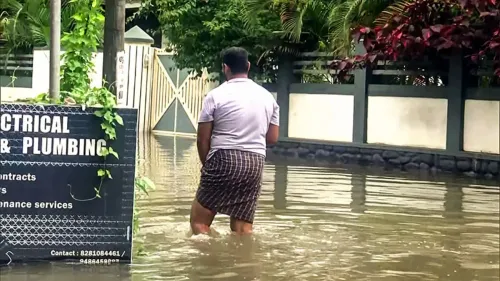DVC’s Preparations for Further Discharge Amid Predicted Heavy Rains
The Damodar Valley Corporation (DVC) plays a crucial role in managing water resources and mitigating flood risks in the Damodar River basin, which spans the states of West Bengal and Jharkhand in India. The DVC is often in the spotlight during the monsoon season due to the significant rainfall and potential for flooding in the region. As more rains are predicted, the DVC’s preparations for further discharge become a critical aspect of its operations, aiming to protect lives, property, and maintain the balance in the ecosystem.
Table of Contents
Historical Context and Significance of the DVC
The Damodar River, often referred to as the “Sorrow of Bengal,” has a history of devastating floods that have wreaked havoc on the regions it traverses. To combat these perennial floods and to harness the river for economic benefits, the DVC was established in 1948. Inspired by the Tennessee Valley Authority in the United States, the DVC aimed to provide comprehensive development through flood control, irrigation, power generation, and industrial growth.
The DVC manages a series of dams, reservoirs, and canals which play a pivotal role in flood control and water management. The key dams include Tilaiya, Maithon, Panchet, and the Tenughat, each with significant storage capacities designed to regulate water flow and mitigate flood risks during the monsoon season.
Predictive Measures and Meteorological Coordination
As more rains are predicted, the DVC’s preparedness hinges on accurate weather forecasts and real-time data monitoring. The DVC collaborates closely with the India Meteorological Department (IMD) to receive timely and precise weather updates. Advanced meteorological tools and satellite imagery enable the DVC to predict rainfall patterns and potential heavy downpours that could affect the river basin.
The integration of modern technology, such as radar systems and automated weather stations, enhances the DVC’s ability to monitor climatic conditions continuously. This data is crucial for making informed decisions about water discharge and flood management.
Reservoir Management and Discharge Protocols
One of the primary responsibilities of the DVC during the monsoon season is managing reservoir levels to prevent overtopping and ensure a controlled release of water. Each reservoir under the DVC’s jurisdiction has a designated Full Reservoir Level (FRL) and Maximum Water Level (MWL). The DVC operates within these parameters to maintain a balance between storing water for future use and preventing downstream flooding.
When heavy rainfall is predicted, the DVC implements a well-structured discharge protocol. This involves preemptive lowering of reservoir levels to accommodate the incoming water. Controlled and phased release of water from the reservoirs is carried out to ensure that downstream areas can handle the increased water flow without experiencing severe flooding.
Communication and Coordination with State Authorities
Effective communication and coordination with state governments and local authorities are vital components of the DVC’s flood management strategy. The DVC maintains constant communication with the disaster management departments of West Bengal and Jharkhand. This coordination ensures that information about water releases and potential flood risks is disseminated promptly to all stakeholders, including district administrations and communities living in vulnerable areas.
The DVC also conducts regular flood drills and preparedness meetings with state authorities to review and refine the emergency response plans. These exercises help in identifying potential gaps in the response mechanisms and ensure that all parties are well-prepared to handle any eventuality.
Community Awareness and Engagement
In addition to technical and administrative measures, the DVC places a strong emphasis on community awareness and engagement. Public awareness campaigns are conducted to educate residents about the risks associated with heavy rains and floods. Information about safe evacuation routes, emergency shelters, and safety protocols is disseminated through various channels, including local media, social media, and community meetings.
The DVC also collaborates with local non-governmental organizations (NGOs) and community groups to enhance the outreach and effectiveness of these awareness campaigns. Engaging with the community not only helps in reducing panic during emergencies but also fosters a collaborative spirit in disaster management efforts.
Environmental and Ecological Considerations
While managing water discharge and flood risks, the DVC also prioritizes environmental and ecological considerations. The controlled release of water is done in a manner that minimizes harm to aquatic ecosystems and biodiversity. The DVC conducts regular environmental impact assessments to monitor the effects of water discharge on the riverine flora and fauna.
Efforts are also made to ensure that the water quality is maintained during discharge operations. The DVC implements measures to prevent contamination of water bodies due to industrial effluents and other pollutants. Maintaining the ecological balance of the Damodar River basin is essential for sustaining the livelihoods of communities dependent on the river’s resources.
Challenges and Future Strategies
Despite the comprehensive preparedness measures, the DVC faces several challenges in managing flood risks. The increasing unpredictability of weather patterns due to climate change poses a significant challenge. The DVC is investing in enhancing its predictive capabilities through the adoption of advanced climate modeling and data analytics.
Another challenge is the encroachment and unplanned urbanization along the riverbanks, which increases the vulnerability of these areas to flooding. The DVC, in collaboration with state authorities, is working towards stricter enforcement of zoning regulations and promoting sustainable land-use practices.
Looking ahead, the DVC aims to enhance its infrastructure and operational capabilities further. Plans are underway to modernize the existing dams and reservoirs, incorporating advanced automation and remote monitoring systems. The DVC is also exploring the potential of creating additional storage capacities through the construction of new reservoirs and inter-basin water transfer projects.
Conclusion
The Damodar Valley Corporation’s preparations for further discharge amid predicted heavy rains exemplify a multifaceted approach to flood management and water resource optimization. Through accurate weather forecasting, strategic reservoir management, effective communication with authorities, community engagement, and environmental considerations, the DVC strives to mitigate flood risks and ensure the safety and well-being of the region’s inhabitants. While challenges persist, the DVC’s commitment to continuous improvement and adaptation positions.








